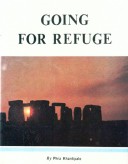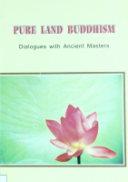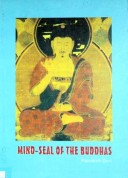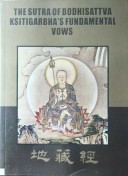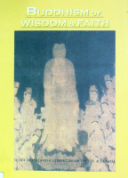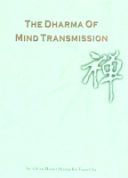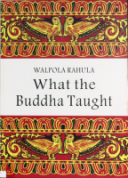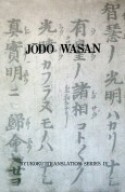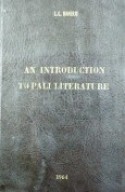Tìm Sách
Sách tiếng Anh-English >> Going For Refuge
Thông tin tra cứu
- Tên sách : Going For Refuge
- Tác giả : Phra Khantipalo
- Dịch giả :
- Ngôn ngữ : Anh
- Số trang : 26
- Nhà xuất bản : The Corporate Body of the Buddha Education Foundation, Taiwan
- Năm xuất bản :
- Phân loại : Sách tiếng Anh-English
- MCB : 1210000003842
- OPAC :
- Tóm tắt :
1210000003842
Pages: 26
GOING FOR REFUGE
- ABOUT REFUGES AND VIEWS
When people have met with the Buddha’s Teaching and perhaps practised it to some extent, sometimes they wish to make the Dhamma their direction in life, their guide through life. At that time their thoughts turn to becoming a Buddhist. They will realize that whole-hearted practice is not possible while still ‘sitting on the fence’ — especially as that practice usually involves the triple prostration!
But then, is that not putting a label on oneself, adopting a view, even limiting oneself? Let us look into these objections first before going any further.
Everything has labels — nouns, names — in this world. Names or labels are just words, not harmful in themselves. It is only when people use the labels they adopt to swell their own sense of importance, to increase their conceit, or for some hidden motive — to gain power, wealth or prestige — that they are wrongly used. There is nothing harmful in the label ‘Buddhist’ because a person truly practising that Path does not quarrel with those of other persuasions, nor look down on them: he is happy that they have some worthwhile teaching.
As to adopting a view, yes, it does mean that one does so. One adopts the views, first of karma (intentional action) and its fruits, and second of Noble Truths which demonstrate what suffering and unsatisfactoriness are, how they come to exist, how they vanish in the absence of their causes and how to practise so that they gradually cease to exist. These views, by practice in conformity with them, show the way out of all views whatever, ‘Buddhist’ ones included.
The argument runs that if one takes up one Path then the wisdom in the others will be neglected, so one would be limited to the view that had been adopted. But supposing that this adopted view, by practice, cleared the mind so that one came to understand all about views, all about theories and Paths, then there would be no need to dabble with many teachings. Also, to make any real spiritual progress, a devotion balanced with wisdom is necessary — one must have given one’s heart to some ideal or be wholeheartedly treading one Path. Making one’s own mixes of different Teachers’ wisdom will accomplish nothing.
So a person who feels like calling himself a Buddhist and practising like one has overcome these initial obstacles. He feels that it would be spiritually profitable to identify himself with the Buddha’s Teachings in the traditional way, that is, by Going-for-Refuge.
The Ancient Teachers explain that ‘Going’ means understanding. Because one understands clearly the greatness of the Buddha as the original Enlightened Teacher, the Dhamma as the practical Path to Enlightenment, and the Sangha as those who have attained Enlightenment by following that Path, so one has a reasoned and balanced faith which makes possible the required effort that is implied in ‘Going’.
Where is one going? From the confusion and turmoil of greed, aversion and delusion, from the uncertainty of countless beliefs, from obstinacy and conceit, along the straight path with no obscurities to freedom from all defilements, the way out of fear and anxiety, to the development of loving-kindness and insight-wisdom, the latter leading to Enlightenment. So it is Path needing knowledge and wisdom and not one for the blind believer.
A ‘Refuge’ is a safe place. It does not mean running away or ignoring what should be known. On the contrary, the Buddhist Refuge in Buddha-Dhamma-Sangha is pre-eminently the safety to be found in wisdom regarding one’s own mind. How is this? True safety can be sought only in what is morally pure and free from deterioration. The Buddha is such a refuge, as we shall see; so is the Dhamma, and the Sangha. All three are aspects of Enlightenment, so the practising Buddhist can go for Refuge within, to the Buddha-Dhamma-Sangha in his own heart. For one who does not practise, however, the Three Refuges remain exterior: the Buddha as the great and inspiring Teacher, the Dharma as the wealth of his discourses or Sutta, the Sangha as the Enlightened Community who have practised well and entered on the good way — but does not yet include oneself.
Other ‘refuges’ that people go to, such as wealth and property, persons other than oneself such as priests, monks, swamis and gurus, or holy places such as churches, synagogues, shrines, temples — and Buddhist temples too — are all unreliable as they can never be interior refuges and are all subject to change and destruction. They may of course be useful in spiritual development, but they are means, not ends. Even religious refuges where the refuge is other, whether a Creator, Saviour or Messenger, are all unsure, because they cannot be known beyond all doubt.
A person who wants to Go-for-Refuge is ready and happy to put down personal views. What are views? They concern all the subjects that one cannot really know for sure but just believes to be true. That such views are false may be seen from the conflicting ideas of various world religions on the subject of the Creator God. Three-in-One, or only One, or innumerable deities as aspects of the One? If such disagreements were limited to words it would not be so bad, but history right up to the present shows that oceans of blood have been shed defending views, or impressing views upon others. At the very least they are the subject of argument and disagreement, which easily provoke enmity or resentment. They cannot be resolved by logic, nor by dispute, nor by force. They are individually believed to be true by ignoring the fact that other people believe, quite as sincerely, opposite views. And individual belief is often strengthened by adherence to a group. If it is a large group, one can appeal to numbers — ‘Well, ten million people can’t be wrong!’ — but if it is a small one, there may be an elitist view — ‘We are the chosen ones (or the occult core), the rest are the hoi polloi common people (Greek) who are doomed.’
All such beliefs concerning religion (politics and nutrition are the two other great fields for view) limit the understanding. They block off investigation of other ways of looking at life. They keep one inside the fold — and one remains a sheep. One accepts an idea, like God, without investigating it, without trying to verify it. ‘Oh’, but they say, ‘you can’t verify God’ — then God has to remain a belief and an illogical one at that. And then whose belief? That of the nearest church, or that of the minister one likes, or that which is sold so convincingly by a doorstep missionary, or that presented with swollen emotion at a revivalist meeting, or that made attractive by ritual… the varieties are infinite.
A belief in a Creator-God cannot go along with the Three Refuges. As the Buddha said, if there is such a belief in a God who orders things as he likes, then there is no way of living a religious life. He has ordered everything (including wars, murders, droughts, starvation, epidemics, and so on) and we are his puppets. He is then the Creator of both Good and Evil and so must have both characteristics in his nature. But, some object, even though he is the Creator, he does not order all matters, but gives man freedom to choose good or evil. But then why give him freedom to choose evil and so be condemned to hell forever? In this theory the Creator condemns his own products. It could be argued that evil comes from elsewhere — Satan — but in this case one must ask, “Who was the Creator of Satan?’ Did God know Satan would fall and become his adversary? If so, he seems to be placing obstacles in his own path. If he did not know, then he is not Omniscient. Suppose another theory is brought up: He created the world and set up its laws, such as the Law of Kamma, but after that took no further part. Then what is his purpose in so doing? If it is all a divine play (lila), as some Hindus suggest, he must indeed be a cruel God, even a demon, to create such a world of conflict and suffering. If his purpose is to display his own perfection, then the words of an ancient Spanish monarch are most apt: “Had I been present at the Creation, I would have given some useful hints for the better ordering of the Universe.” (Alphonso the Wise c. 1270). So, if he wished to save human beings, why not order things better from the beginning? Of course, one will be told by God-believers that God’s will is inscrutable. However, such an answer merely means ‘I do not know’ and this is admitting ignorance. And the overcoming of ignorance is what Dhamma is about. ‘God’, in fact, is another word for spiritual, mental and emotional ignorance.
Views are also obviously tied up with conceit. Indeed one is conceited by the way one conceives. Conceiving some religious belief time and again converts it into truth. The mind manufactures ‘truths’ for itself to believe in! We are fooled by our own minds! Our conceit is that we know the truth due to having conceived it — and we are prepared to defend that conceit (equal to the old word for concept). So we are conceited because we conceptualize! And the more of this there is, the more views there are. A person with many views, who is an ‘expert’ on many things, is very conceited, sometimes unbearably so. If those views concern religion, such a person creates disharmony. If they concern Dhamma, he is right off the rails. Dhamma is putting down views.
Apart from ‘creation by God, the Buddha said two other views should be given up: one is the theory that all that is experienced now Is the result of past karma; the other, that things happen without any pattern of causation. In the first case this must be called a species of fatalism. It is still very widespread, and one hears people say ‘It’s my karma’, accepting some situation, when they ought to make efforts to change it. This kind of view makes any positive change impossible.
The last of these three views, by regarding everything that happens as causeless, fails to discern the1 different roots of motivation. A person holding such a view cannot understand: this is wholesome, that is unwholesome. If these are not distinguished, what is unwhole some (greed, hatred and delusion) will not be abandoned, and the wholesome (non-greed, meaning generosity, renunciation, selflessness; non-hatred, meaning loving-kindness, compassion, non-delusion, meaning understanding, insight, wisdom) will not be cultivated. It is a convenient view to cloak unwholesomeness.
All three views imply that the individual has no power to cultivate wholesomeness or to abandon what is unwholesome. If this is so, there is nothing to be done: just let everything happen as it will. A good excuse indeed, whether one uses God, past Kamma, or causelessness, for utter negligence and the certain growth of evil.
- MENTAL FACTORS HELPFUL TO AND OBSTRUCTIVE OF GOING-FOR-REFUGE.
First let us look at those factors which strengthen the desire to go for Refuge. The most important is called ‘rooted faith’ (mulika saddha). Rooted in what? It should be rooted in, or based on, understanding and wisdom. Usually it comes about like this…… Suppose an intelligent person reads a Buddhist book or attends a talk or meditation session given by a Buddhist Teacher. After that experience there is a certain amount of knowledge. That knowledge has been conveyed in terms which are both reasonable and practical. Having practised (perhaps meditation every day in one’s home), one finds that confidence arises. One goes to see that Teacher about some problem in life or with meditation. Again he explains what to do about it or how to use some wholesome method to overcome the difficulty. One is pleased with this and confidence grows stronger. Not only one’s heart is pleased but one’s intellect is satisfied because of the thoroughness and clarity of the Teacher’s explanation. So then, deep faith and trust arise in the Buddha-Dhamma-Sangha and one desires to go for Refuge.
In this illustration of what is meant by faith or confidence in the Triple Gem, three distinct but interrelated aspects stand out: the first is obviously faith itself. But why does faith arise on the basis of some contact with the Dhamma? This is because of the presence of the second aspect — one’s mind feels pleased and satisfied. This means the presence of some wisdom (panna). That it is present for some but not for others is sometimes explained by a past connection with the Dhamma — that is, having practised it in a past life, the mind feels happy and pleased at having rediscovered it. The third aspect of Buddhist faith is that it is associated with clarity, brightness, purity and serenity of mind. This is partly intellectual and partly emotional. These three aspects are all summed up in the word pasada (a synonym of saddha — faith), a term which is therefore untranslatable into English. So if saddha is rendered as ‘faith’, the three aspects above have to be remembered as contained in that word. In the discourses of the Buddha saddha-pasada are often used in combination when speaking of one who goes for Refuge to the Triple Gem.
Likewise, helpful for this is wisdom (panna). Later we shall look at some unintelligent ways of Going-for-Refuge and Keeping the Precepts, all rooted in delusion. Wisdom helps to clear the mind of this and makes understanding easier. Where it is strongly found in a person, only a brief Dhamma-teaching is needed and they are fully satisfied. They may even penetrate to the truth of Dhamma at that time. It is as though just the smell of a good meal is enough to allay hunger. Others, still bright in wisdom, realize its truth after hearing it expounded in detail just once — as though one plateful is enough to relieve hunger pangs. Still others, not so bright in wisdom, need to hear Dhamma again and again: they may be compared to people who have to eat many things in order to feel satisfied. Last, the Buddha spoke of those whose wisdom is so limited that, though they hear the Dhamma, it never means more to them than so many words and they never, in that life, attain to it. They can be likened to people who are never satisfied though they eat mountains of food.
The quality of mildness and gentleness (mudita) is also favourable for Going-for-Refuge. A rough, angry person is not likely to be attracted to the Dhamma unless there is present considerable wisdom as well. The Dhamma helps to calm all roughness of mind, speech and body, so that anger is gradually abandoned and loving-kindness is steadily strengthened. Loving-kindness (metta), the love for all beings including of course oneself, leads a person to express himself gently whether in words or in bodily actions.
Last, straightforwardness or uprightness (ujuta) may be mentioned. People attracted to Going-for-Refuge should have this, for it means that they have no deviousness or disguised motives, such as we shall mention later. Such people are not deceitful and can be relied upon. This implies that the Precepts are well kept.
Coming now to the mental factors opposed to Going-for- Refuge, ‘unrooted faith’ (amulika-saddha) should be listed first. This is faith guided by delusion and means that any doctrine or any person will be believed, sometimes without question. Such people are credulous. They lack wisdom to question their beliefs, a fact that comes more sharply into focus when it is seen that they do not want to understand. Below, under the section on ways of Going-for-Refuge, we shall have something to say about such sheep.
Delusion (moha) is obviously the root of all this, here meaning dullness, lack of understanding and intelligence. How can the profundity of the Dhamma be understood when the mind is clouded in this way? And when it is, the Refuges are not likely to appear attractive. They will be regarded in some confused way and no benefit will be seen in them.
Deluded states of mind, however, do not have to be dull. Intelligent people too can be strongly deluded when it comes to views. And if they do not cling to some set form of belief, they may be prone to another of delusion’s manifestations: sceptical doubt or uncertainty (vicikiccha). This allows people to play about with ideas without the need for the hard work of practice. Their ideas, usually derived from readings on many religions and philosophies, instead of leading to a purification of self and a lessening of self-importance, only make them more uncertain, or more conceited. The latter will be dealt with below; here uncertainty and doubtfulness mean that people go to a Buddhist monastery for meditation practice, while there their thoughts may roam to the Hare Krishnas, and they wonder if they haven’t got the truth. But then when they reach the Hare Krishnas, they are wondering whether it isn’t Guru Maharaji who has the answer — and so on. The list can equally well include wanderers in and out of the various forms of Christianity and other theistic religions. People like this never settle down to any spiritual teaching, for their doubtful questions always move them on elsewhere. And even where there are good answers, as in the Buddha’s Dhamma, to all questions, because their affliction is rooted In delusion, they will not be able to accept them, or will misunderstand them with all sorts of unnecessary complications. Such is sceptical doubt.
Conceit (mana) has been mentioned already. If one has conceived (thought, conceptualized) about oneself or about some theory dear to oneself many times, it then becomes a fact which must be defended. That defence and the arguments it involves, together with the possibility of anger arising, all show how powerful conceit can be. Such conceits (concepts) cannot be put down easily. They are clung too tightly. They are in fact a refuge for the deluded, for they develop into views and those in turn become fixed patterns of thought, what Buddhists call ‘unwholesome pathways of mind-karma’. Once such ‘tracks’ are worn in the mind they become the paths that the mind always follows without question. Overactive minds that think too much, that are full of too many ideas, lead to the development of strong conceit. This is a defilement most difficult to be aware of and to treat, because it supports the whole notion of self-soul. Only good mindfulness, long practice and insight (vipassana) will lessen it or cut it off completely.
Along with delusion and conceit goes obstinacy (thambha). When conceit is strongly established and views have been built upon it, the only thing that is likely to shake them is a catastrophe. Arguments, be they ever so clear, will never move such deeply rooted views. Even if the views that are clung to are shown to be not merely illogical but for the harm of that person, they will still be adhered to. This is a kind of hardness and rigidity of mind which cannot accept new ideas though they are clear and helpful. It goes along with prejudice and is of course just another minion of the great General Delusion.
III. CONTENT OF THE REFUGES
Taking the Refuges in the usual order, the Buddha is placed first. The Buddha-refuge has this honourable place because a Buddha discovers the Dhamma. The latter is always true, for all times and places, but it is not always known and has to be rediscovered by the courageous effort of one completely dedicated to truth. ‘Our Buddha, the one who found again the ancient highway of Dhamma and who has left details for us to follow, was called Gotama, known to some as Sakyamuni, the Sage of the Sakyas. Many times in his teachings we find him saying that one who goes sincerely for Refuge to the Buddha does so with the following ideas in mind: “Indeed the Blessed One is thus: the accomplished destroyer of defilements, a Buddha perfected by himself, complete in clear knowledge and compassionate conduct, supremely good in presence and in destiny, knower of the worlds, incomparable master of men to be tamed, teacher of devas and men, awakened and awakener, and the Lord by skilful means apportioning Dhamma.” This is not the place to expound these nine virtues in detail. It is sufficient to say that the Buddha is sot therefore either to be regarded as a philosopher, just another teacher who taught just one more way, or as an infallible guru whose words should not be questioned, or even as an aspect of the Divine, a messenger of a higher power. These are all extremes and involve seizing various views. In the first case there is no going-for-refuge to a philosopher, as his teachings are merely “a system of logic beaten out by his own reasoning” (the Buddha’s words on the philosophers of his days); however good his logic and truthful his teaching, it has not been verified though practice and penetration. All the Dhamma taught by the Buddha, however, was seen with penetrative insight as true and beneficial. This first extreme is too intellectual and ‘dry’ — it lacks faith and confidence.
If the Buddha is treated as a guru to be followed blindly, as gurus are usually followed, this will be the second extreme, one dominated by emotion. There may be plenty of faith but no wisdom, so that even if such people describe themselves as Buddhists, theirs will be an ‘unrooted faith’.
More extreme still is the view regarding the Buddha as divine, not really human. If so, we can only pray to him, we cannot practise what he taught and certainly we cannot find what he found. Buddhas, in this view, are totally transcendental and-acquire all the trappings of an omniscient God. It is not wonderful that such Buddhas can find Enlightenment, for what, in the ordinary view, cannot God do? But we poor mortals cannot do much in that way; we shall have to be the Buddha’s devotees and then in what way shall we differ from God’s devotees? This is the way of blind faith. One cannot go for refuge to such a Buddha because he is not human.
Still less can refuge be sought in a Buddha conceived of as a messenger from a higher power. Buddhists never regard the Bringers of Enlightenment as messengers or as subject to some more or less concealed God. Note that in the list of the Buddha’s nine virtues ‘Teacher of devas and men” is one. Not only human beings, but vast numbers of devas (literally ‘shining ones’ — angels), deities, gods and spirits wars taught by him. He did not go to them, or even to one of them, such as Great Brahma (the name of the supposed Creator-God in India at that time), for Instruction; they all came to him to ask questions. Many discourses are preserved where greater or lesser divine beings question the Buddha — and some of them as a result of their questions reached some stage of Enlightenment. Further, he is a “Buddha perfected by himself”, that is, by his own efforts at practising Dhamma. He does not owe his Enlightenment to any other power. Buddhist art never shows rays of light descending upon the Buddha from above: light is shown as emanating from his person “complete in dear knowledge and compassionate conduct”.
The Buddha-refuge remains an exterior one while the Dhamma is not practised. But when it is, the Buddha-virtues grow in one’s own heart until, with complete purification through insight-wisdom (vipassana), the Dhamma-truth in all its fullness is seen there. One would then be described as Buddha — awakened, enlightened, or as an Adamant — one who is of supreme worth. Generally the word ‘Buddha’ has tended to be used for the rediscoverer of Dhamma, while ‘Arahant’ is used to describe those enlightened after practising the Dhamma in full, but these terms do overlap: the Buddha is described as an Arahant (“the accomplished destroyer of defilements”) in the first of the nine virtues, but he himself often spoke of enlightened people generally as ‘Buddhas’.
The Dhamma, second among the Refuges, is thus in the middle between Buddha and Sangha. This too is an honourable place, for if there were no Dhamma, no Truth, Law, Teaching, Path, there could be no Buddha and no Sangha.
Refuge in the Dhamma is on two levels: confidence in the law of karma and its fruits, and confidence in the Noble Truths. Both the fruiting of karma and the casualty of the Noble Truths and beyond the range of knowledge of people at the beginning of their practice. But confidence in both these subjects is very useful in reducing dukkha both in oneself and in relation to other people. Confidence that karma works means that one will conduct oneself accordingly. When we say ‘confidence in the working of karma’, this means that one understands that wholesome intentional actions produce the fruit of happiness, good opportunities. Intelligence, health and so on, while unwholesome intentional actions fruit as sufferings mental and physical, obstructions of many kinds and poor opportunities, or none at all. If one really understands this, an effort can be made to change the direction of one’s life. How much dukkha is avoided by this! One does not make the causes for it, so the unpalatable fruits do not have to be experienced.
The confidence in the Noble Truths is related to this. Already one knows something of one’s own dukkha. When one hears the Buddha’s words on the First Noble Truth, describing the extent of it, and when one reflects on those words again and again, much more of it becomes clear: “Birth is dukkha, decay is dukkha, death is dukkha; sorrow, lamentation, pain, grief and despair are dukkha; association with what one dislikes is dukkha, separation from what one likes is dukkha, not getting what one wants is dukkha; in brief, the five grasped-at aggregates are dukkha, which are as follows: the grasped-at aggregate of the body, the grasped-at aggregate of feeling, the grasped-at aggregate of perception, the grasped-at aggregate of mental formations, the grasped-at aggregate of consciousness.” doth is the extent of dukkha (which there is no room here to describe in detail!). One has enough already — no need to make morel The cause of the dukkha, the Second Noble Truth, is In one’s own heart — craving. It is possible therefore to do something about the dukkha. If dukkha was produced by some exterior agency, for instance, ‘God tries us by sending suffering’ or ‘How so-and-so makes me suffer!’ or This damn thing won’t go right!’ There would be little or nothing that could be done about dukkha. As it is though, the dukkha born of mental conflict and defilement can be abandoned altogether, while the experienced in the body can be lessened. Obviously, the dukkha of decay or ageing and of death cannot be avoided, completely, but even they can become bearable. The Third Noble Truth, of Cessation of Dukkha, means that if the causes are removed the results will vanish, so remove craving and ignorance, or greed, hated and delusion, and the dukkha produced by them will no longer be experienced. The Fourth Noble Truth is the Path or means by which this can be done and here the Noble Eightfold Path is always explained. There Is no place here to expound It in detail and it must suffice to say that It consists of moral conduct, meditation and wisdom.
Confidence in these two aspects of Dhamma will be one’s Refuge in the Dhamma. Certainly, no other teaching is so clear and so profound, so true to immediate understanding and so true when inspected in depth. Hence it was said the Dhamma: ‘The Dhamma of the Blessed One is perfectly expounded, to be seen here and now, not delayed in time, inviting one to come and see, leading inwards, to be known. He wise each for himself.”
Refuge in the Sangha can only be truly secure when the Sangha, meaning here ‘community’, is ennobled with Enlightenment. To this community, consisting of monks and nuns, laymen and laywomen who have seen the Dhamma in their own hearts, either completely or in part, one who is practising the Dhamma goes for Refuge, understanding that such people are true guides to Enlightenment. Some who are fortunate may have personal contact with such Teachers and can then practise the Path with their guidance. Others may not know anyone like this but be inspired to practise by the knowledge that the Noble Sangha exists.
The Noble Sangha means Stream-winners, Once-returners. Non returners and Arahants, the first three having verified the Dhamma to some degree, while the fourth Noble Person, the Arahant or one who is completely worthy, has penetrated its truth so that there is nothing further to do. Although one is not yet a part of the Noble Sangha, this can be accomplished through practice. When one gets one’s feet on the Path of Stream-winning, some aspects of the Dhamma have been verified, such as the existence of Nibbana, so that one’s confidence in the Dhamma becomes unshakeable and one will never turn to any other Teacher apart from the Buddha. Then one is established firmly In the Refuges.
Until that happens, the Sanghas of bhikkhus (monks) and bhikkhunis (nuns), although they consist of ordinary people with defilements, do have a special discipline and conduct and if practising strictly are fine exemplars.
- SIMILES FOR THE REFUGES
In this section are quoted a few poetic-illustrations of the relationship of the refuges to each other. They are drawn from the Commentary to the “Minor Readings” (Khuddaka-patha).
‘The Buddha is like the rising sun; the Dhamma is like the web of his rays; and the Sangha is like the world rid by him of darkness…… The Buddha is like a great rain-cloud; the Dhamma is like a downpour of rain; and the Sangha, in which the dust of defilement has been laid, is like the countryside in which the dust has been laid by the fall of rain…… The Buddha is like a good trainer of thoroughbreds; the True Dhamma is like the means for disciplining thoroughbred horses; and the Sangha is like a mass of well-disciplined thoroughbreds…… Or else the Buddha is like a clever physician because he is able to cure the sickness consisting of defilement by underlying tendencies; the Dhamma is like a rightly applied medicine; and the Sangha, whose underlying tendencies to the sickness of defilement are quite cured, are like people whose sickness is quite cured by the application of the medicine … Or else the Buddha is like a good guide; the Dhamma is like a good path to a land of safety; and the Sangha is like people who enter upon the path and reach the land of safety…… The Buddha is like a good pilot; the Dhamma is like a ship; and the Sangha is like people who have succeeded in reaching the further shore…… The Buddha is like a good friend; the Dhamma is like helpful advice; and the Sangha is like people who have reached all their aims through following the helpful advice…… The Buddha is like a mine of riches; the Dhamma is like the vein of riches; and the Sangha is like people who exploit the vein of riches…… The Buddha is like an opened lotus flower; the Dhamma is like the honey produced by that flower; and the Sangha is like a swarm of bees making use of that honey.”
- WAYS OF GOING-FOR-REFUGE
There are some illustrations too about how one goes for Refuge — in a number of foolish ways and in the way it is done by a wise person.
Some people go for Refuge like parrots. These birds are quite clever and adaptable and can manage to repeat human words — but they have no idea what they are saying! In the same way we find Buddhists’ mouthing the words ‘Buddham saranam gacchami”, but knowing their meaning no more than clever parrots. To prevent this, a translation into the vernacular should follow these words: ‘To the Buddha I go for Refuge”. It must not be forgotten that when the Buddha spoke in Pali to the people it was than the vernacular.
Another kind of refuge-going is in the manner of sheep. These animals of small intelligence follow the leader without knowing where they are going, so, in a similar fashion, some repeat the Refuges just because their leader does. The Buddha did not want people to be sheep-like followers; he taught Dhamma to them so that they could investigate it for themselves and know it for themselves. Then they would become bold like mountain lions, not stupid like sheep.
The donkey is another illustration of the wrong way of going for Refuge. Donkeys are stubborn and can only be moved by hard punishment or the persuasion of a carrot. So it is with some people who obstinately adhere to views: they can only be moved to repeat the Refuges if they see a carrot — some advantage for themselves, or a stick — some punishment or trouble. In the Buddha’s Teachings though, the stick has never been used to convert others, while to use the carrot method is not so good either. Only wisdom is needed. Those who require sticks or carrots will have to go on being obstinate donkeys!
Refuge-going like a deer is also possible. The deer is a timid beast always alert to danger. So are some people beset by fear and driven without understanding to become Buddhists. It is true that this world is beset by dangers and fears, but this is not the best motive for refuge-going — wisdom is needed for that.
Then there is Going-for-Refuge like a crow. With its beady eyes it struts around always on the lookout for some tidbits. If there is Going-for-Refuge in this way, it is done only for personal gain, that is, motivated by greed.
A monkey can be taken as illustration too. It is an animal hardly ever still, always on the move and looking for new things. So when a person of very distracted mind says, ‘To the Buddha …”, his mind is already off to something else and he cannot complete even that one sentence with concentration. This is why the Ancient Teachers advised that the Three Refuges should be repeated three times, then once at least they would be spoken with mindfulness and understanding.
Finally, there is Going-for-Refuge like a wise man. This method is approved by the Buddha since the motivation is clear understanding rather than defilements.
- THE PRECEPTS AS FIRST STEP ON THE PATH
After declaring one’s intention to practise the Buddha’s Path it is the right time to begin! In the usual formulation of that Path, virtue, or moral conduct (sila) stands first, before meditation (samadhi) and wisdom (panna). And the usual form of virtue for lay followers is the Five Precepts (panca sila). Here is a brief account of the content of each precept. One should bear in mind that the Precepts are not designed as rules to govern every possibility: they are guidelines, and to use them properly wisdom should be employed. The general principle is every case is: how to cause the least possible harm and suffering, both to myself and to other living beings? When difficult situations are investigated in this way they can usually be resolved. When this method is used, the fundamental principles of Dhamma — wisdom and compassion — are demonstrated in a very practical manner, that is, one is wise because, knowing one’s own good, one does not harm oneself and sees the way to promote one’s own happiness; and one is compassionate since, the good of others being known, one does not harm them and in fact sees the way to promote their happiness.
First Precept: “I undertake the rule of training to refrain from killing living beings.” In every precept this means to refrain intentionally from breaking it. Living beings which are killed when one goes for a walk, digs the garden or just breathes the air are not counted, because there is no intention to kill them so no unwholesome karma is made. This world is a place where beings feed on each other — either they are the eaters or the eaten. By undertaking this precept one minimizes the sufferings that one will cause them and one intends to lead a life free from violence. Sometimes, because all living beings have their own desires, there will be conflict. Do you, for instance, let rats or cockroaches take over your house so that you have to move out? That would be one solution but scarcely one motivated by wisdom! And what should be done with unborn children who are not wanted? In the case of the first question, perhaps some method of getting rid of these creatures can be found which will not kill them. But if there is no such practical method then you must employ the way of riddance which will be the least painful and harmful. The second question also involves conflict of interests. It seems, from a Buddhist point of view, that an abortion can only be justified where the mother’s health would be in danger. Although the karma of terminating a pregnancy will not be as strong as killing a human already born, it will still be a powerfully unwholesome act; something to ponder well before doing. This illustrates how there is a scale of unwholesomeness in killing. Obviously, the same amount of hatred (dosa), the usual root of killing, is not involved is spraying the aphis on one’s cabbages and murdering a man. In the first case we call it dislike but it is still dosa, though a fairly mild variety, while in the second it is much stronger and may vary too in its strength. Where murder has been planned, in thinking over the details many times, the karma involved becomes heavier and heavier, but where it is done out of sudden anger the karma is less strong. Where killing has been done at the orders of another, as by a soldier in the army, it may be less powerful but, on the other hand, with such a livelihood one may become hardened to violence and gradually dry up in oneself any loving-kindness and compassion that was present in the first place. This is also true of slaughtermen and hunters. As for ‘sportsmen’ who hunt or fish ‘for fun’, they can have little compassion indeed and no justification. The result of breaking this precept is that one has only a short life (if born human) and one full of suffering.
Second Precept: “I undertake the rule of training to refrain from taking what is not given.” This precept covers all sorts of actions which people would not call stealing. There is a word for theft in Pali but here the Buddha did not use it, perhaps so that a wider range of activities could be included. Taking what is not given’ includes theft as well as such acts as using for one’s own ends the means of one’s employers when not authorized to do so — ‘knocking off’ excess supplies (‘They won’t notice, they’ve got too much already’), not doing a fair day’s work but expecting to receive a full wage, and its reverse, not giving a fair wage for a day’s work. Included here are also any kind of fraud that deprives people of their wealth and all sorts of underhand business manipulations as a result of which wealth increases at the expense of honesty. The unwholesome root behind all these actions is generally greed. Although usually less violence is used in breaking this precept, still enough suffering can be caused by it. As one wishes to live long in the possession of one’s own property, so one should not deprive others of theirs. The results of the karma of so doing are to be born in poverty and receive nothing from others. How bad these conditions will be depends on how strong the karma of taking what is not given was. Again, there is a difference according to what is stolen and whom it is stolen from. Removing some postage stamps or stationery from the office will obviously have a different result to the violent theft of a poor old person’s savings. And if the nature of the victim is virtuous, or indeed noble, the results that can be expected become worse and worse.
Third Precept: “I undertake the rule of framing to refrain from wrong conduct in sexual relations”. There is no special standard in this precept. The same standard — not harming oneself and” not harming others — applies here as elsewhere. People should be able to decide on this basis what constitutes ‘wrong conduct in sexual relations’. Obviously, this would be the case when a third party broke up an established relationship. Another example is rape. Seducing or perverting children is yet another. In all of these cases great suffering is caused just because people who are supposed to be adults have no restraint to their desires. This precept illustrates very well the practical nature of Buddhist ethics. The Buddha knew very well the power of sexual desire and so laid down a precept which is quite liberal in its standards. There is no mention of marriage here because this was not one well-defined state as it is in western religious tradition. Instead of the standard depending on the performance of a set ceremony, the Buddha defines breaking this precept in terms of the conflict and trouble caused — and certainly it causes and has caused terrible sufferings. As with the other precepts, there is a scale of evil-doing involved in breaking it. About the worst results can be expected from the rape of a nun who is Enlightened — an Arahant like Uppalavanna in the Buddha’s days. But there are few nuns and so practically the worst will be any violent sexual assault. This karma will fruit in untold aeons of suffering. Also, breaking up any loving relationship will bear very heavy fruits for the one who does it.
Fourth Precept: “I undertake the rule of training to refrain from false speech.” Dhamma is the path of truthfulness — and it leads to discovery of the Truthful Dhamma in oneself. That Truthful Dhamma, one formulation of which the Four Noble Truths, cannot be so known if one has not started along the way with truthful speech. Falsehoods only gain one a reputation for unreliability, while truthfulness leads others to trust. Millions of people have trusted the Buddha, those who saw him in person as well as those who have heard or read his words, because what he says is so obviously truthful. That truth may have a slightly bitter taste to those gripped by the defilements, but those who want to practise recognize there a Dhamma free from cloying blandishments. As with the other precepts, wisdom should be used in speaking the truth. For example, where the whole truth would be too painful for the listener, part of it may be stated. However, the intention should not be to deceive the other and so gain some advantage for oneself. And one should know the right time and place for truthful statements, especially if they may be hurtful. The Buddha said that he spoke such words only at the right time, that is, when they would benefit the listener, as bitter medicine may sometimes cure sickness. This precept is broken only when others are deceived by one’s deliberately misleading words. It is not broken if they misunderstand what one has said so that actually they know the truth. Lies are of various kinds and have a fruit in accordance with their gravity. Generally though, the fruit that they bear in future existences is that no one will trust one.
Fifth Precept: “I undertake the rule of training to refrain from intoxicants such as liquors, etc., causing carelessness.” How would it be possible to be truthful and to keep the other three precepts ‘if one were careless, heedless, neglectful or lazy? All intoxicants — whether drunk, chewed, sniffed, smoked, injected or rubbed on the skin — change the mind and make it less aware of how things really are. Either they dull perception, as is usual with alcohol, or they seem to heighten it by changing the content of what is perceived in some way; but they do not change one’s defilements — greed, aversion and delusion — which remain the same or are even strengthened. Their use does not lead to a mind which is always clear and attentive, alert and full of understanding. They cannot, therefore, be regarded as an alternative route to Enlightenment as some western (and eastern) gurus have proposed. Only virtue, meditation and the wisdom born of this will lead to Enlightenment. It means hard work on oneself! The lazy will tend to favour the view that it can be done through drugs! Apart from this, all these substances are escape chutes away from insight-wisdom into suffering and into the darkness of ignorance and negligence. The dukkha caused by taking these substances is incalculable, a greater mountain than the dukkha from which the users seek escape. Carelessness is the opposite of mindfulness-and-wisdom, the twin qualities which when cultivated brighten up the mind. The whole of the Buddha’s Teaching Is based on their growth. When mindfulness is present, the Five Precepts can be kept easily; when it is present, meditation Is successful; and then too wisdom can arise which sees things the way they really are. Carelessness should be guarded against even in the practice of the Precepts and is needed even more for meditation and insight-wisdom. So the fifth precept is very important: when it is broken the other four can be broken too, but it is kept in purity, the mind brightens and Dhamma-practice succeeds.
The Five Precepts are not, as can be seen, just arbitrary rules but are the sure foundations for one who wishes to follow a spiritual life. For the Buddhist, they are the first step along the Buddha’s Path, and for those who do not wish to follow his way they would provide an excellent basis of virtue. They are unblamable by wise people anywhere, in fact the wise will always praise them for their clarity and practicality.
VII. WAYS OF KEEPING THE PRECEPTS
As this world does not consist only of wise people, so there are various ways of undertaking the Precepts. As in the case of the Refuges, some examples can be given of this.
First is the kind of precept-keeping compared to a blind man with a diamond. Someone puts a hard round object into his hand and says, ‘Keep it carefully!’ To him, however, it seems just like a stone and as this particular one is unintelligent too, he does not ask about it but just throws it away. So are some people with the Precepts which they undertake to keep but carelessly, not knowing their value. Equally carelessly they break the Precepts.
Then there is the example of precept-keeping like a politician. These people are well known for promises which later they find themselves unable to keep, or they may have had no intention to keep them in the first place. This is undertaking the Precepts with an eye to advantage, not out of sincerity but rather from hypocrisy.
Precept-keeping like a lawyer is also possible. This man knows the laws and the ways round them. When the Precepts are undertaken in this spirit, infringements are quickly excused and subtle arguments brought forward out of self-justification.
There is also precept-keeping like a puritan. While the blind man represents ignorance and delusion, and the politician and the lawyer are on the side of greed, the puritanical attitude is rooted in hatred. A person of this sort may keep his precepts pure in a fanatical way, all the while blaming others who do not keep theirs. His face is unhappy with the strain of forcing himself to adhere to a moral standard, rather than letting this become the natural level of behaviour as it does when mindfulness and meditation are cultivated.
The wise person keeps the Precepts carefully but not fanatically. Such a person tries not to break precepts but if this happens, he does not blame himself but earnestly renews his efforts. And precepts are not for the harm of others, so that, if they will be hurt by the keeping of them, one should use wisdom to consider what to do. Still, this must not be made an excuse for breaking them I When they are kept diligently and wisely they indicate a wise person, one who knows his own happiness and that of others too.
VIII. THE CEREMONY OF GOING-FOR-REFUGE
The form of this varies as there are no ceremonies which are done in the same way everywhere in the Buddhist world. ‘Is it necessary to have a ceremony at all?’ ‘Didn’t the Buddha talk about the fetter of adherence to rites and rituals?’ Questions like this are asked sometimes. The answer to the second one is that meaningful ceremonies — those that are in accordance with Dhamma, are not included in that ‘fetter’. People are fettered when they grasp at rituals or vows as the essence of religion, so that only one way of doing things is ‘right’ and will achieve the desired results — liberation, salvation and so on. But the goals of the spiritual life cannot be won by rituals, although for those who are just getting their feet on the path they may be useful. Even then, rituals should be simple and straightforward. If they start by being complex and highly symbolic, after a few centuries they will become intricate and so complex that Dhamma gets forgotten.
The need to have a ceremony for Going-for-Refuge will vary with different people or communities. Certainly the ceremony draws a community together and emphasizes commitment to the Triple Gem.
The main parts of such a ceremony are the offerings, prostrations, repeating the Refuges and Precepts, and Dedicating and Merits.
Regarding the ‘offerings’ there are a few words of explanation. Usually, in English, this word implies that there is someone ‘on the other end’ who will accept them, but In the Buddhist sense these things are expressions of gratitude and reverence. They are not made thinking that the Buddha will accept, or reject, them. Those who are Enlightened, even during their lives, are beyond the happiness of what others give or the sorrow of what they do not. The Pali word for the traditional ‘offerings’ — flowers, incense and lights — is sakkara, meaning ‘what should be done’, that Is, out of gratitude and reverence, but English has no suitable word.
Flowers symbolize impermanence, as in traditional verse from Sri Lanka:
‘The Buddha I revere with varied flowers, by this, my merit, may there be released; even as this flower fades away so will my body
 Facebook
Facebook
 Google
Google
 Google+
Google+
